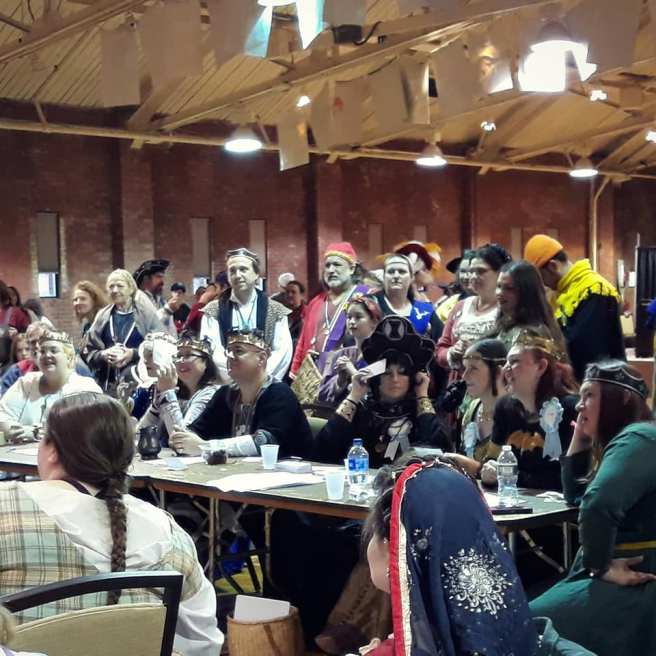Probably the crappiest attempt at 17th C. Imperial Russian you’ll ever see, but it was coated in bling so it doesn’t matter.
This story begins, as so many do, with the quintessential opening of, “So no sh*t, there I was…” It was February of 2016. I was at a tiny pop culture convention at UConn with some friends who I’ve known in the comic artist circuit for no less than googlety years.
…Yes, I draw, by the way. My first degree is in art, and I’ve been working on and off in the pop culture industry now since 2002. The latest thing I churned out was this Master Chief for my brother-in law. This is not relevant to my post. I just wanted to show it off because I slayed that bristol board.

Long story short, I had secured badges for San Diego Comic-Con International, yes, the big one, and I was chatting it up with a friend in our hotel room on a freezing cold night in Storrs, CT. She randomly suggested something along the lines of, “You should totally do a historically accurate Black Widow.” And I only half heard it. So while she was talking about art, I heard “costume for Comic-Con”, and the rest was history.
The kicker was getting in a position to make it before the con. Our move from New Hampshire to California had already been scheduled, and I was in the middle of writing and sewing my thesis. So what it came down to was waiting until I actually lived in San Diego to get started. This would not have been so bad, if we didn’t wait a month for our household goods to come in. When all was said and done, I had 3 weeks to pull it together. I began ordering supplies before I had a sewing machine in my house, and basically launched this project on a Hail Mary.
Since I made this for convention cosplay, versus SCA wear, I decided to focus on the look of the costumes from the 1903 Ball at the Winter Palace, in which the theme was to wear 17th Century court dress. So it was already going to be anachronistic in addition to costumey. I chose the look of the coat of Grand Duchess Xenia Alexandrovna, sister of Czar Nicholas II, and the kokoshnik from another noblewoman.
I shorted the hem of the layers to make sure I wouldn’t trip and fall in a convention center. I used every machine trick I had to save time, and collected plastic beads, rhinestones, vintage beaded trims, buttons with black widow spiders on them, and embroidered patches churned out on a friend’s embroidery machine. In the end, most of the handwork involved was just on the kokoshnik. I threw lace on the forehead instead of beads, because I don’t know how to do that type of beading and there was like zero time to try to learn. The patterns are overly simplified to facilitate speed. I’m pretty sure Russian coats were not made like t-tunics.
I was sewing up to the night I wore it, but it paid off in the end: I was awarded a hall costume blue ribbon from the Hollywood Costumer’s Guild, and got to meet Terry Dresbach, the former costume designer from “Outlander”, who immediately recognized my attempt at a historical version of Black Widow. I didn’t get my picture with her, but I did with others from their group.
Here is a full gallery of the construction and wearing of the costume at SDCC. Note the crazy nuances like my makeup, and nose ring. This was never intended for SCA wear, it’s more like a Las Vegas Imperial Russian.
And then the costume got put away in my closet, and came out again for Costume College in 2017, but I didn’t wear it.
And then the 2019 Birka Garb Challenge was announced as “Marvel and DC Superheroes and Villains”, and I was like, “Well, okay. I’m skipping this one. Unfair.” And then I got talked back into it. Originally, I was going to enter as Thanos in full crazy 12th Century Byzantine complete with chased and repoussed “armor” as a loros, and then decided I didn’t want to do that much work. So, I backed out again, in prep of doing the medieval persona hike here in Trimaris in February at Corsair’s Heart, which I figured would give me a better avenue for re-wearable garb.
…And then I got asked to trot this haute mess back out. Since nobody back in the East Kingdom actually saw it in person, I had a few people who really wanted me to bring it. I had even more people who didn’t remember, or know, that I did this, so when I posted a few pics to social media that one was coming out of the vaults, I think it really intimidated a lot of other participants. For their benefit, and my own, I decided I wouldn’t enter the fashion show, and opted in to judging it instead, which, honestly, was so much fun, I would totally do it again. I loved sitting on the panel and admiring all of the entries with the other judges, TRM East, Her Highness East, and Her Highness Atlantia. We had an absolute blast.

So yeah, if you saw this, and wondered what the frack it was, this is what it was. The ribbon hangs in my studio, underneath a ribbon I won at Arisia 2009 for my first ever Byzantine ensemble. They’re a nice reminder to stay humble. 😉






































You must be logged in to post a comment.